Papers by James F Doyle
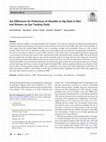
Evolutionary Psychological Science, Jun 27, 2019
Shoulder to hip ratio (SHR) is a sexually dimorphic trait in humans, yet no previous study has in... more Shoulder to hip ratio (SHR) is a sexually dimorphic trait in humans, yet no previous study has investigated the gazing behavior and perceived physical attractiveness of men and women in relation to men and women's SHRs. Men and women are attentive to men's upper body and consider higher SHRs as cues to masculinity, strength, and formidability. Moreover, while women's shoulder width varies from one individual to another, to our knowledge no previous study has investigated perceived attractiveness and eye movement in relation to women's SHR. Therefore, in the current study, we investigated attractiveness ratings and eye movements of both men and women to front-and back-posed male and female stimuli varying in SHR. Our results showed that men prefer more masculine ratios for men and less masculine ratios for women. However, the results also showed that women preferred an intermediate SHR for both men and women in the back view while their preference in the front view is not influenced by SHR. Eye movements showed that men viewed the chest region of other men in the front and back views of stimuli, and they had longer dwell time on chests of male stimuli with higher SHRs, while no significant difference was found for dwell time on chests of female stimuli varying in SHR. Also, no differences were observed for female participants in dwell time, for either chest regions of SHRs of male stimuli or for the chests of female stimuli. Altogether, the results of this study suggest that men more than women are attentive to variations in SHRs. Keywords Shoulder to hip ratio. SHR. Physical attractiveness. Eye tracking. Sex differences. Formidability Adolescent and adult skeletal sexual dimorphism is influenced by dimorphic androgen serum levels (Kasperk et al. 1997), which facilitate differentiation between male and female body forms (Barber 1995; Grammer et al. 2003; Pazhoohi and
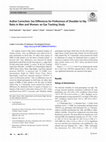
Evolutionary Psychological Science, 2019
The original version of this article contained mistakes. In Abstract section, "Also, no differenc... more The original version of this article contained mistakes. In Abstract section, "Also, no differences were observed for female participants in dwell time, for either chest regions of SHRs of male stimuli or for the chests of female stimuli", is incorrect and "Also, differences were observed for female participants in dwell time for the chest region (i.e., upper back) of back posed male stimuli" is correct. In the Eye Tracking subsection of Results, "a 3(SHR: Low, Intermediate, High) by 3(ROI: Head, Chest, Waist, Hips/thighs, Legs/Feet) repeated measures ANOVA", is incorrect and "A 3(SHR: Low, Intermediate, High) by 5(ROI: Head, Chest, Waist, Hips/thighs, Legs/Feet) repeated measures ANOVA" is correct. In Discussion section, "Also, no differences were observed for female participants in dwell time, for either chest region of SHRs of male stimuli or for the chest of female stimuli (Fig. 4). Consistently, recent research has found no differences for attentional biases to regions of interest as a function of the waist to chest ratios (Garza et al. 2017; Garza and Byrd-Craven 2019)" is incorrect, and "Similarly, female
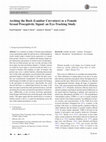
Evolutionary Psychological Science, 2017
It is common in studies of human mate preference to have participants judge the attractiveness of... more It is common in studies of human mate preference to have participants judge the attractiveness of photographs in which models adopt a neutral facial expression or a neutral body posture. However, it is unlikely that humans adopt neutral expressions and postures in normal social circumstances. One way in which posture can vary is in the curvature of the lower spine. In some non-human animals, a "lordotic" posture (in which the lower spine is curved towards the belly) is associated in females with readiness to mate. In humans, this posture may serve a similar function, attracting heterosexual men. In this study, participants were presented with computergenerated images of female bodies in which the back curvature was systematically manipulated. The result showed that small changes in lumbar curvature are associated with changes in the perception of attractiveness. Specifically, the result showed that there is a relationship between the range of the back curvatures used in this study and attractiveness, such that increasing the curvature increased the perception of attractiveness. Additionally, as the curvature increased, participants looked longer and fixated more on the hip region of the female bodies. This paper argues that the attractiveness of women in lordotic posture is due to a conserved mechanism across the taxa which signals proceptivity to men.
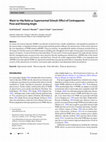
Archives of Sexual Behavior, Jun 18, 2019
In women, the waist-to-hip ratio (WHR) is an indicator of attractiveness, health, youthfulness, a... more In women, the waist-to-hip ratio (WHR) is an indicator of attractiveness, health, youthfulness, and reproductive potential. In the current study, we hypothesized that viewing angle and body postures influence the attractiveness of these forms based on the view dependency of WHR stimuli (vdWHR). Using eye tracking, we quantified the number of fixations and dwell time on 3D images of a female avatar in two different poses (standing and contrapposto) from eight viewing angles incrementing in 45 degrees of rotation. A total of 68 heterosexual individuals (25 men and 43 women) participated in the study. Results showed that the contrapposto pose was perceived as more attractive than the standing pose and that lower vdWHR sides of the stimuli attracted more first fixation, total fixations, and dwell time. Overall, the results supported that WHR is view-dependent and vdWHRs lower than optimal WHRs are supernormal stimuli that may generate peak shifts in responding. Results are discussed in terms of the attractiveness of women's movements (gaits and dance) and augmented artistic presentations.

It is common in studies of human mate preference to have participants judge the attractiveness of... more It is common in studies of human mate preference to have participants judge the attractiveness of photographs in which models adopt a neutral facial expression or a neutral body posture. However, it is unlikely that humans adopt neutral expressions and postures in normal social circumstances. One way in which posture can vary is in the curvature of the lower spine. In some non-human animals, a “lordotic” posture (in which the lower spine is curved towards the belly) is associated in females with readiness to mate. In humans, this posture may serve a similar function, attracting heterosexual men. In this study, participants were presented with computer-generated images of female bodies in which the back curvature was systematically manipulated. The result showed that small changes in lumbar curvature are associated with changes in the perception of attractiveness. Specifically, the result showed that there is a relationship between the range of the back curvatures used in this study and attractiveness, such that increasing the curvature increased the perception of attractiveness. Additionally, as the curvature increased, participants looked longer and fixated more on the hip region of the female bodies. This paper argues that the attractiveness of women in lordotic posture is due to a conserved mechanism across the taxa which signals proceptivity to men.
This study tested the hypothesis that the frequency of non Western male’s use of mate retention t... more This study tested the hypothesis that the frequency of non Western male’s use of mate retention tactics decreases with age. Results from 244 Iranian female partner’s self reports of their Iranian male mate’s mate retention tactics are presented. It is shown that the reported frequency of mate retention tactics is not associated with the female participant’s age, relationship status, or use of oral contraceptives and that the reported frequency of mate retention tactics decreases as these men age. Additionally, analysis showed that the age difference between the Iranian women respondents and their male partners did not result in more frequent use of mate retention tactics; counterintuitively, age difference was negatively correlated with mate retention tactics. Results, limitations, and the role of testosterone supported by the outcome of this study are discussed.
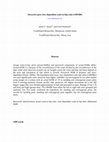
"Actual waist-to-hip ratios (actual-WHRs) and perceived components of actual-WHRs differ: Actual-... more "Actual waist-to-hip ratios (actual-WHRs) and perceived components of actual-WHRs differ: Actual-WHR is a measure of the circumference of the waist divided by the circumference of the hips, while what observers actually see are lengths across the waist and hips and these depend on the pose and orientation of that which is viewed. Perceived WHR is dynamic and view-dependent (Doyle, 2009a). The hypothesis that lower view-dependent waist-hip ratios (vdWHRs) are rated significantly more attractive than higher vdWHRs was investigated in two pilot studies using images of a woman with an actual-WHR of .70 in standing and contrapposto poses taken from 8 viewing rotations - frontal, profile, side, posterior- (45 degree increments for a full 360 degree range) that were divided approximately in half and presented as pairs. Ratings of low (.70 and less) and high (greater than .70) vdWHR from either the left or right side were grouped and analyzed. Our first study confirmed the hypothesis for standing and contrapposto poses, the second for standing pose, standing and contrapposto pose together, but not contrapposto pose alone."
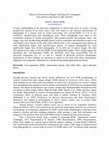
To gain understanding of the perceived components of waist-to-hip ratios in various viewing persp... more To gain understanding of the perceived components of waist-to-hip ratios in various viewing perspectives, patrons of an exotic dance club were asked to rate physical attractiveness of photographs of a woman with an actual waist-to-hip ratio (actual-WHR) of 0.70 in two conditions: squared-stance and contrapposto pose. These photographs were taken at 45° incremental rotations in frontal, front-profile, side, posterior-profile and posterior views. The images were also divided along medially-placed vertical centerlines and presented in pairs to be individually rated. Results of this pilot study indicate that; 1) the contrapposto pose photos are rated significantly higher than squared-stance photos, 2) original photographs are rated significantly higher than divided photographs, 3) for both sets of paired images, the sides showing the lower, right or left side WHRs scored significantly higher. These results support the hypothesis that view-dependent WHRs are differently rated than actual-WHRs, and are perceived components (i.e., S+, S- and S++ stimuli) of physically attractive photographs. Implications of these findings are discussed in regard to the peak shift effect, phylogenetic adaptation and ontogenetic attunement in a model incorporating signal detection theory.

Journal of Social Evolutionary, and Cultural …, 2009
Men are attracted to the movements of women's bodies. The aim of this paper is to answer the ques... more Men are attracted to the movements of women's bodies. The aim of this paper is to answer the question: what is the mechanism? The role of the peak shift effect in perceptions of physical attractiveness involving women‟s waist-to-hip ratios (WHRs) in biological motion is presented. Photographs of a coordinated motor pattern, walking, are investigated with a novel measurement method. Evidence is presented that the behavior pattern contains alternating left and right side, attractive (S+) and unattractive (S-), WHR stimuli. A WHR stimulus range is established that is sufficient to generate peak shift effects in perceptions of physical attractiveness. It is predicted that WHRs in attractive behavior patterns will be significantly lower than those previously found to be preferred using 0.70 WHR still images. Therefore WHRs in motion represent S++, or “supernormal stimuli”, in behavior.
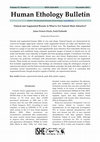
HUMAN ETHOLOGY BULLETIN, 2012
Natural and augmented breasts differ in size and shape. Natural breasts are characterized by conc... more Natural and augmented breasts differ in size and shape. Natural breasts are characterized by concave-to-straight upper-pole contours while augmented breasts are fuller and therefore may have convex upper-pole contours, irrespective of their size. The hypothesis that augmented breasts in a range of cup sizes are rated significantly more attractive than naturalistic breasts was investigated and confirmed using computer generated images of breasts in lateral-view by all males and females cross-culturally in English and Farsi speaking samples. Correlations were then used to show that, for all participants, breast area and breast displacement (concavity or convexity) are positively correlated with attractiveness ratings for natural but not augmented breasts. These results are counter-intuitive since humans could not have evolved in environments that included augmented breasts. The findings are introduced using the ethological concept of supernormal stimuli and the behaviorist/neuroaesthetic principle, the peak shift effect, applied to secondary sexual characteristics (i.e., waist-hip ratios and breasts) and it is concluded that augmented breasts, though deceptive signals of fertility, are supernormal stimuli.
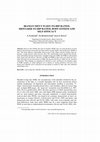
Journal of Evolutionary …, 2012
Waist-to-chest (WCR) and waist-to-shoulder (WSR) ratios are good predictors of male physical attr... more Waist-to-chest (WCR) and waist-to-shoulder (WSR) ratios are good predictors of male physical attractiveness and women have been shown to prefer higher waist-to-hip ratios (WHR) in men. This study addresses relationships between men’s body shapes and their feelings about appearance, weight and how others perceive them. The experimental results reported here demonstrate relationships between Iranian men’s shoulder-to-hip ratio (SHR) and WHR on self-reported body esteem and self-efficacy. Increases of SHR and WHR in these men were positively correlated with body esteem and increases of SHR with general self-efficacy. BMI was not correlated with either. These findings are interpreted in reference to men’s preferences for feminine ranges of WHR regardless of actual biological sex in relation to varying preferences that have been found cross-culturally and to self-perceived masculinity in relation to their mate and coalitional membership value.
Conference Presentations by James F Doyle

The goal of this project is to develop a ‘peak-shift’ index to assess the attractiveness of behav... more The goal of this project is to develop a ‘peak-shift’ index to assess the attractiveness of behavior patterns, rather than images alone. Waist-to-hip ratio arrays comprised of data collected from video recordings of behavior patterns (e.g., walking, dancing) will be sorted using the selection sort algorithm. These view-dependent WHRs, derived from unknown actual-WHRs, will be used to create a ‘peak-shift’ index. Sorted arrays will be used to find image data of: 1) less than .69, the peak-shifted elements, 2) .70-.72 intermediate elements and 3) greater than .72 elements. In short, data collected from behavior patterns will be sorted and searched. The hypothesis that lower WHR elements increase viewing time will be tested. Webpage version with videos: http://www.ethomotion.com/sorting-and-searching-behavior-patterns-analyzing-whr-arrays-with-the-selection-sort-algorithm-ishe-2010-poster-2/

Men are attracted to the movements of women's bodies. The aim of this paper is to answer the ques... more Men are attracted to the movements of women's bodies. The aim of this paper is to answer the question: what is the mechanism? The role of the peak shift effect in perceptions of physical attractiveness involving women's waist-to-hip ratios (WHRs) in biological motion is presented. Photographs of a coordinated motor pattern, walking, are investigated with a novel measurement method. Evidence is presented that the behavior pattern contains alternating left and right side, attractive (S+) and unattractive (S-), WHR stimuli. The presence of a WHR stimulus range that is sufficient to generate a peak shift effect in perceptions of physical attractiveness is established. It is predicted that WHRs in attractive behavior patterns will be significantly lower than those previously found to be preferred using 0.70 WHR still images. Therefore WHRs in motion represent S++, or "supernormal stimuli", in behavior.
Abstract: Religions are integral to cultures worldwide, their prevalence and persistence suggest ... more Abstract: Religions are integral to cultures worldwide, their prevalence and persistence suggest that they fulfill human wants and needs. A foundational religious practice is the marriage ceremony, which contractually grants and obliges the betrothed access to each other while making their commitment known to the community. Throughout the animal kingdom the attempt to retain access to desirable conspecifics is termed mate guarding. If religions provide a means for humans to mate guard, religious behavior may have embedded adaptiveness. This study seeks to bring attention to the questions: does religion provide a socially sanctioned role for human mate guarding and if so, is there a positive correlation between self-reported religiosity and measures of mate retention?
Videos by James F Doyle
Drafts by James F Doyle











Uploads
Papers by James F Doyle
Conference Presentations by James F Doyle
Videos by James F Doyle
Videos: https://www.youtube.com/playlist?list=PLppqXqNObO6tUICooCq7jR6jZHpE6PWj5
Webpage describing how these videos were used: http://www.ethomotion.com/sorting-and-searching-behavior-patterns-analyzing-whr-arrays-with-the-selection-sort-algorithm-ishe-2010-poster-2/
Poster: https://www.academia.edu/3288889/Sorting_and_Searching_Behavior_Patterns_Analyzing_WHR_Arrays_with_the_Selection_Sort_Algorithm
Drafts by James F Doyle
Videos: https://www.youtube.com/playlist?list=PLppqXqNObO6tUICooCq7jR6jZHpE6PWj5
Webpage describing how these videos were used: http://www.ethomotion.com/sorting-and-searching-behavior-patterns-analyzing-whr-arrays-with-the-selection-sort-algorithm-ishe-2010-poster-2/
Poster: https://www.academia.edu/3288889/Sorting_and_Searching_Behavior_Patterns_Analyzing_WHR_Arrays_with_the_Selection_Sort_Algorithm